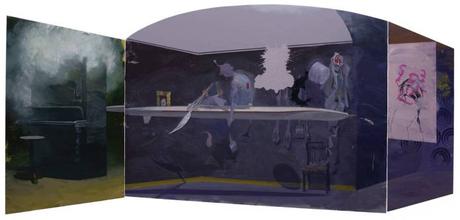
State of the Art (c) Ruprecht von Kaufmann
‘It is impossible,’ says Merleau-Ponty (2012 [1945]: 221), to paint about painting.’ He contrasts painting with the self-reflexivity of speech which can turn in on itself infinitely. And yet Ruprecht von Kaufmann, in his impressive retrospective exhibition in Erfurt, Germany, boldly offers us a kind of modern altarpiece, ‘State of the Art,’ which seems to be precisely a painterly contemplation on what painting is and where it is going. The panels seem to unfold like an altarpiece in an old German church, but in fact they are flat against the wall: the perspective is built into their skewed frames and continues in the lines of the pictures. From the outset the painting toys with our perception and toys with our smug art historical expectations. It raises a physical challenge to our interminable discussions about painting; for language proves, after all, ‘equally uncommunicative of anything other than itself’ (Merleau-Ponty, 2012: 219).
The left wing houses a blazing piano whose narrow side is painted in rough, grainy, horizontal slashes that are cut sharply into a perfect vertical line–a painterly impossibility, unless one makes use of some non-traditional tool, like a stencil. Where the paint meets this stencil it rises to a proud precipice, defiantly thick. The piano seems wedged behind a smoky bar, but the long, thin counter proves to be a hovering canoe, whose subtle modulations of color would also be impossible to paint save for the long and carefully prepared hooked curve of a stencil that determines its border. Its edges are licked pink, flaming between the sedate purple and indifferent white, giving them a diffuse glow even while they wrap around sharp edges.
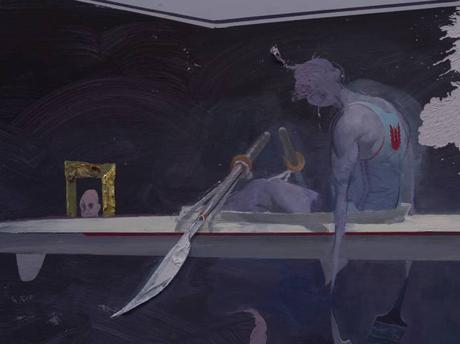
State of the art (detail) (c) Ruprecht von Kaufmann
In the boat is a sorry looking figure. His painting-arms–for they end in brushes–hang limp and useless. Beyond him, in the final panel, flat and hasty modernist scribbles recede impatiently around a corner. Von Kaufmann seems to be in a devastating limbo. His works lack the shrewd indifference or even scorn towards narrative expected of the contemporary painter. But perhaps his painting is, in a sense, ‘accidentally narrative,’ in the way Merleau-Ponty (2012: 174) argues that a poem is. Beneath the images conjured up by the words of a poem lies the poem’s real power: its pulsing, rhythmic incantation loosely caresses its story but it leads, he insists, ‘in the reader’s mind, a further existence which makes it a poem’ (2012: 174). The force of its delivery lingers in our minds, not the synopsis, and our memory of that electrifying encounter stays with us long after the plot is lost to us. ‘A novel, poem, picture or musical work,’ ventures Merleau-Ponty (2012: 175) ‘are individuals, that is, beings in which the expression is indistinguishable from the thing expressed.’
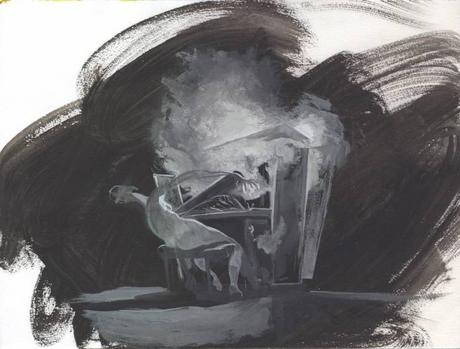
Etude (c) Ruprecht von Kaufmann
Floating in this uncertainty, von Kaufmann puts on his painting-arms anyway. He brandishes them with the fury of the piano player in the small gouache study ‘Etude,’ who plays on relentlessly with quivering, bendy arms while the whole thing goes up in smoke. Behind the hovering, inert painter (who is about to be hit with a bucket of paint) hangs other equipment ready to be assumed: his ordinary hands, more brushes, and a cluster of gracefully hooked shapes. It takes me a minute, but then I recognize them: some stencils hang from the wall with a languid drape, curling with the glamour of Nouvelle Vague cigarettes, seductive as a Jugendstil arc across any reputable Viennese Kaffeehaus door. The painter might wearily pull on his brushes, but he might also adapt–
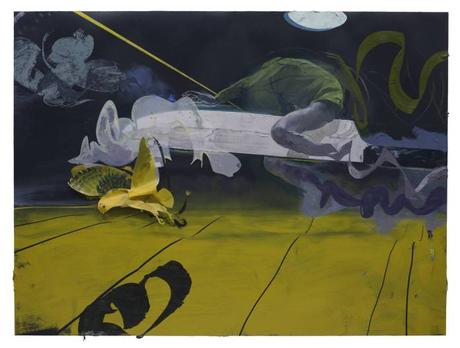
Flucht (c) Ruprecht von Kaufmann
Suddenly the stencils are everywhere. What would be discarded is offered triumphantly to our view, laid at the altar of painting. I see their crisp, cool results in the slick noses of sharks and I see their untiring reiteration of geometric patterns. But I also see them painfully and meticulously describing complex floor tiles in exaggerated perspectives, and I see them as sensually abstracted flat shapes. Von Kaufmann knows their rhythms intimately, he sees them scattered about the landscape of his studio, he eyes them as he dutifully attends to emails and escapes, momentarily, into their undulating forms, flattening them, in his mind, into lusciously rolling shapes, before abandoning his emails to paint them so: abstractions of abstractions, main protagonists formed of discarded remnants, paintings devised out of the very tools of painting, and out of unconventional and disposable tools at that. Von Kaufmann slips into his painting-arms and paints–defiantly, belligerently, compellingly–about painting.
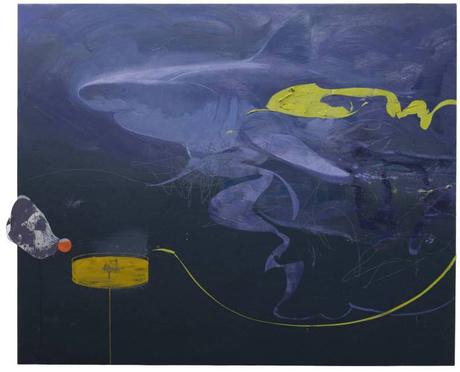
Perfektion (c) Ruprecht von Kaufmann
The inevitable final step is that the stencils break away from the pictures, wearing the residue of the paintings on their smooth skins as they stalk the gallery, looming as embodied thought. I stand, at last, face to face with the unearthly human forms of strangely graceful sculptures that von Kaufmann has fashioned from these remnants, breathing the same air that flows between their fanned rib cages. I cast a quick look about the gallery, shocked at being entrusted with this vivifying secret. But no one else seems to notice. They approach the sculptures–thoughtfully pieced together with astounding anatomical care, with graceful kinks offsetting ribs and pelvis, and swollen calves, with a sturdy turn of the knee and the sure fastening of hamstrings to fibula–with predictable detachment, accustomed to greeting clusters of garbage in galleries. They fail to grasp that all are one: that, intoxicated with the act of creation, possessed by the same sick obsession with galvanism as Mary Shelley, von Kaufmann has animated the very tools of expression, granting them their existence as beings, as individuals.
Tumble (c) Ruprecht von Kaufmann
But the studio remains haunted with doubts and other tiny evils. ‘The Atelier’ towers as a false diptych. It is light and grand and littered with deceptions: benign decapitations, casual self-cannibalism, banal skulls that make up the satin ripple of the wallpaper. But most arresting is the break between the panels. It is not at the dramatic pictorial division, where the studio is propped up like a film-set. This rift between red and white trails off into a wash of strokes that reveal the painterly artifice that it is, while the real division shatters the glass of the mirror. Von Kaufmann, with the head of a rabbit, sits stiff and paralysed. His wife is sturdy and solid and human, uncovered and unshakable, sensible in her house shoes, a woman really seen, something sure among the sham. Her earthiness is grounding. She is a delicate balance between flesh and drapery, like the melting woman of ‘Take off your skin,’ whose legs, painted with ribbon-like delicacy, seem to curl endlessly in on themselves like Möbius strips.
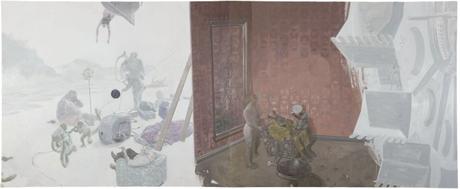
The studio, 8 years of my life as Mr Lampe (c) Ruprecht von Kaufmann
Sometimes this firm but fluid drawing softens into something more loose and flat, like the legs in ‘In the house,’ a five-panel painting that traverses some intensely emotional territory across its breadth. These legs revert to gentle outlines with the loving wobble of a Klimt leg, rounded out by two or three subtle tones laid crudely next to one another. A slumped figure is composed entirely of looping outlines filled in banana-yellow, garish against the subdued purples, as if a caricature of himself, of his own maddening powerlessness, shut off from the turmoil behind the door. These softened human imprints constantly vie with the sharpness of stencils and with the exacting slopes of edges of rooms and stairways, whose disconcerting perspective refracts across breaks in the panels. The low-slung moon, thick and pocked with holes through horizontal waves, gleams artificially against a scraped violet-blue sky, cut out by a perfectly circular stencil. The bed escapes this technical tension; its soft ripples wrap expertly around a solid form with a pleasing virtuosity, its pearlescent tones are hushed and close and its strokes are swift and free.
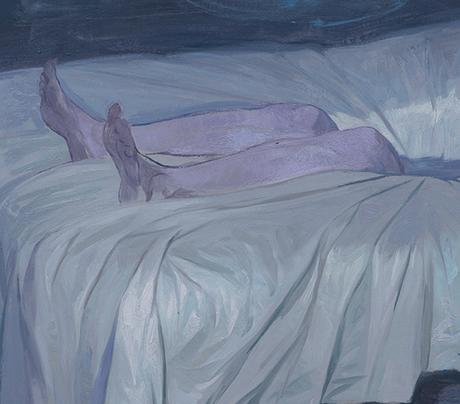
In the House (detail) (c) Ruprecht von Kaufmann
Perhaps the clash between human and tool is most violent in the long series of remembered heads, the ‘Zuschauer’ (‘spectators’). Von Kaufmann seems intent on finding an elegant summary of each person, an understated string of loving lines to cup a face and distill its delightful individuality. But the painting bites back. Von Kaufmann goads it out of submission, gouging its lino surface instead of gently smoothing paint across it, slicing it and swapping its parts around, or overloading it with chunks of paint. Each eruption of paint latches onto something of the painted spectator, who willingly parades themself as they desire to be seen. But each presentation is met with a judgement, and the paint betrays that judgment. Full and dewy lips are rendered in bleeding, streaky paint. Large glasses alluding to intellect perch upon an aloof face, and von Kaufmann carves them in deep, hollow circles. A proud girl with a lovely tilt of chin and charming cheekbones is all but erased by a flat slab of gold paint, and von Kaufmann seems to sneer at her bland anonymity behind her polish, before piling a rough blob of the glitzy substance in the middle of her vacant face. Whether they seem to gaze dreamily at a starry sky, or stew knowingly in their sagging skin, or wear their bright lapels proudly, or leer from gaudy Hawaiian shirts, von Kaufmann teases them with the cruel painterly pleasure he takes in their lopsided ears, their bulbous noses, the undersides of their copious chins as they raise their heads and prattle on endlessly. And he never lets them stare him down: their evasive eyes softly dissolve like sugar sunken into coffee, nothing more than smoky circles in their sockets.
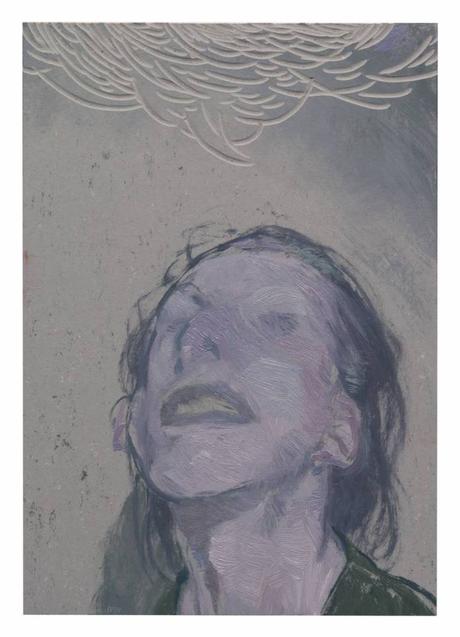
Zuschauer (c) Ruprecht von Kaufmann
The spectators seem to suffer a painterly fate akin to Deleuze’s (2003: 98; 99) ‘diagram’–the controlled chaos that he attributes to the smeared faces painted by Francis Bacon, the part of the painting freed from intention and left to the harsh irreverence of the hand. Indeed, the stencils permit exactly that–they define a limit within which von Kaufmann can enact a mindless physical fury at odds with the rest of the painting process, that would otherwise spill destructively into other regions and swallow up the picture. But von Kaufmann has found more than a clever tool in his stencils, for his rough patches, rather than wreaking disaster on a painting, seem rough in a directly human response to innovations and developments in painting. A stencil could, in the hands of another, be a crutch, an assistant to a lazy painter. Von Kaufmann defies the stencil and pushes its possibilities, he uses it not for ease and perfection but rather to reveal what paint is, its viscosity and willfulness, and to show us how inescapably human painting is. Every frenzied texture that wrestles through a stencil is a declaration about painting. Von Kaufmann does not carelessly disrupt his paintings. Rather, he thrashes painting to life, extracting every last drop of expression from every last part of it–even from the tools and the substrate–awakening it into a being, into an organism of paint.
Whatever von Kaufmann’s private doubts about painting may be, he keeps probing perception, probing existence itself, until the paintings assume their own existence, silently stewing and imposing their alternatives on us. His work always clings to a story, certainly, and prods us to discover one. But in so many ways they are paintings about painting, thought through the act of painting itself; the presence they give to these thoughts is far more deep and honest than this inadequate tribute of words. Every time von Kaufmann puts on his painting arms, he inhabits painting even as it inhabits him, he fuses seamlessly with his tools like bike and rider and surges on relentlessly, and we can no longer say where the brush ends and he begins.
Prometheus (c) Ruprecht von Kaufmann
Deleuze, Gilles. 2003 [1981]. Francis Bacon: The Logic of Sensation by Gilles Deleuze. Translated by Daniel W. Smith. 1 edition. London: Continuum.
Merleau-Ponty, Maurice. 2012 [1945]. Phenomenology of Perception. Hoboken: Routledge.
‘Die Evakuierung des Himmels‘ runs until 02 April 2018 at Kunsthalle Erfurt, Germany. Do it!
